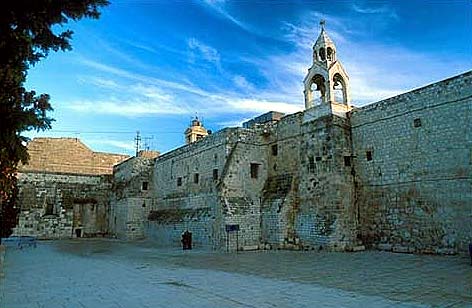Fearing that the 1,500-year-old roof of Bethlehem’s Church of the Nativity, one of the "Holiest Sites in the World", could collapse at any time, the Palestinian Authority is looking into how to repair the wooden and leaking top of the basilica built by the Byzantine Emperor Justinian around 6oo A.D.
The Church of the Nativity
“After centuries of neglect, the ancient and dilapidated roof of Bethlehem’s Church of the Nativity will finally undergo renovation next year,” reports Bible History Daily, the journal of the Biblical Archeology Society, which says the roof was last repaired around the time of the U.S. Civil War.
“While the leaky roof long ago ruined many of the church’s priceless mosaics and paintings,” reports the journal, “of more immediate concern are the roof’s ancient wooden beams, which have begun to pose a danger to the more than 2 million
Inside the church
Actually, the roof has not undergone major repairs in more than 500 years, reports Robert Berger of the Voice of America, “because of a feud among the three Christian denominations that control the church — the Catholics, Greek Orthodox and Armenians. But in the spirit of goodwill for Christmas, they put their differences aside.”
However, such a project is more archeology than carpentry. That’s why
“It’s a very, very special site. It’s famous — and I’m not speaking just about Christianity here, but world heritage. It’s extraordinary,” he told Randy Boswell of the Canadian daily National Post.
An original church at the site, built by the Roman emperor Constantine I in 330 A.D., was destroyed 200 years later. The existing church was erected in its place.
A damaged mosaic inside the church
“Located on the spot said to be the birthplace of Jesus Christ, the Church of the Nativity is one of the most sacred Christian sites in the world,” the U.S.-based World Monuments Fund stated in 2008, when it placed the deteriorating church on its annual watch list of globally endangered heritage sites.
“The roof timbers of the church are rotting, and have not been replaced since the 19th century. Rainwater seeps into the building and damages not only its structural elements but also its 12th-century wall mosaics and paintings. Due to this influx of water, there is also an ever-present chance of an electrical short-circuit and fire.”
Site where Jesus is said to have been birthed
Last year, after Roman Catholic, Armenian and Greek Orthodox officials who jointly manage the site agreed under pressure from the Palestinian Authority to repair the building, Busuioc and Italian experts completed a high-resolution, diagnostic laser scan of the church’s walls, floors and roof in January.
“Since then, the collected data has been shared with other experts and exhaustively analyzed to create a work plan for rehabilitating the famed pilgrimage site — the most important tourist attraction in the Palestinian territories,” reported Boswell.
A statue of St. George damaged by leakage
“What was critical in this phase was the roof,” Busuioc told the Canadian agency Postmedia News. “It looks fragile, but it still supported us, as we had to go directly on the roof to collect data. But this is very critical, and it’s the first action. Replacing the roof should start next year.”
The building has an inspiring, “penetrating spirit,” he said.
“He particularly recalls round-the-clock shifts with his colleagues,” writes Boswell, “and sometimes having ‘the fortunate privilege to start the day at sunrise’ — to schedule as much of the scanning as possible around the needs of the clergy and pilgrims.”
He called pending two weeks, day and night, at the site “a great honor.”
Renovations will cost $10 to $15 million and will be funded by the Palestinian government and international donors, according to Palestinian Tourism Minister Khouloud Daibes.
The Church of the Nativity is the Palestinian Authority’s top tourist attraction, drawing around 2 million visitors a year.






